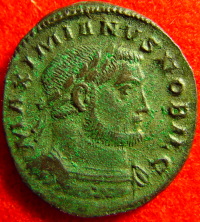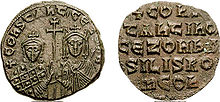Follis

Roman coin
The follis (plural folles) was a large bronze coin introduced in about 294 (actual name of this coin is unknown [1]) with the coinage reform of Diocletian. It weighed about 10 grams and was about 4% silver, mostly as a thin layer on the surface. The word follis means bag (usually made of leather), and there is evidence that this term was used in antiquity for a sealed bag containing a specific amount of coins. The follis of Diocletian, despite efforts to enforce prices with the Edict on Maximum Prices (301), was revalued and reduced. By the time of Constantine, the follis was smaller and barely contained any silver. A series of Constantinian bronzes was introduced in the mid-4th century, although the specific denominations are unclear and debated by historians and numismatists. They are referred to as AE1,AE2, AE3 and AE4, with the former being the largest (near 27 mm) and the latter the smallest (averaging 15 mm) in diameter.

Byzantine coin
The follis was reintroduced as a large bronze coin (40 nummi) in 498, with the coinage reform of Anastasius, which included a series of bronze denominations with their values marked in Greek numerals. The fals (a corruption of follis) was a bronze coin issued by the Umayyad and Abbasid caliphates beginning in the late 7th century, initially as imitations of the Byzantine follis.

See also: Roman currency, Byzantine coinage.
References
- ^ accessed 22 September 2006 http://dougsmith.ancients.info/voc5.html
